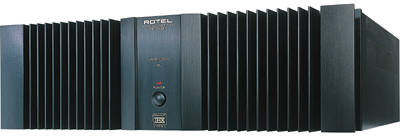| Columns Retired Columns & Blogs |
Rotel RB 1080 power amplifier
What could be easier to review than a power amplifier? No features or functions aside from inputs, outputs, and a power switch. So when Jonathan Scull asked if I could help out by taking on the Rotel RB 1080, which another reviewer hadn't been able to get to, I accepted the assignment. Before I could click my heels and say "FedEx!" twice, Rotel's 200Wpc RB 1080 had appeared.

I'm old enough to remember the Dyna Mk.II, which for the first time allowed impecunious audiophiles who had ogled Marantz and McIntosh equipment to acquire a power amp capable of driving nearly any speaker on the market. Later, in the 1980s, the Adcom GFA-555 rewrote that declaration of independence for Krell cravers, its 200Wpc capable of driving nearly any contemporary speaker.
Today, 200Wpc is still a lot of power, and is not commonly available for $1000. So despite the changing times, the Rotel RB 1080 offers a a lot of watts per buck. Moreover, the 1080 is far from a stripped-down device. Its sculpted front panel is decidedly more stylish than those of its utilitarian ancestors. It offers selectable balanced (XLR) and unbalanced (RCA) inputs, and has an input for low-voltage, remote power control. In fact, the made-in-China Rotel RB 1080 looks like a high-end amp, with specs to match.
The accompanying CD-ROM and DVD-ROM take the new owner on a simulated 3D fly-by tour of the 1080's innards, the pilot's voice describing points of interest along the way. Once past the Rotel-manufactured 1.2kVA toroidal power transformer, we fly over Vishay and Roederstein metal-film resistors, fancy slit-foil film capacitors designed by DNM's Dennis Morecroft, multiple power-output devices, and steep, cliff-like heatsinks that run from front to back on each side of the chassis. These inboard heatsinks do their work well; the sculpted front-panel extrusions, which look like heatsinks, are just pretty.
Playing in the Big Leagues
I briefly skimmed the Rotel's instruction manual (more warnings against stupid misuse than anything else), unpacked the amp, and plugged it into my main system. I used my usual balanced interconnect (AudioQuest Python) and speaker (AudioQuest Granite) cables to patch the RB 1080 in between the Sonic Frontiers Line-3 preamplifier and the Revel Studio speakers, pushed the button on the Rotel's front, and off we went.
The 1080 was virtually noiseless (except for the music), and my first impression was of a somewhat soft, dry sound lacking in dynamics. Balance across the audible spectrum was smooth, with tight, impressive bass, but there seemed to be a lack of presence. The treble was clean and detailed. Such hastily formed opinions are as often wrong as they are right; in the case of the 1080, they were mostly right but definitely incomplete.
With the unlikely load of the Revel Studios, the $1000 Rotel had two discrete personalities. At low levels, such as one might use for casual listening, the characteristics were as described above. I was persistently bothered by a microdynamic compression that sucked life out of the music, even though the really big moments did not lack for impact. I was also disturbed by a reticence in the treble that, by contrast, made the extreme treble transients of cymbals and triangles seem a bit over the top (!).
But when I turned up the volume, the 1080 came to life. The glossing-over of small dynamic changes was replaced by a clarity of inner detail that can happen only if subtle dynamics are not lost. Even allowing for the presence-region shifts that are the concomitant solely of playing louder, the Rotel-Revel combo became a bit more forward at high levels as the treble smoothed out. And, except for the sacrifice of domestic tranquility, nothing was lost in macrodynamic potential as the RB 1080 drove the Studios to quite impressive levels, and on down into the nether reaches of the lowest bass. Whether it was the dynamic and emotional extremes of Mahler's Symphony 5 (Zander/Philharmonia, Telarc 2SACD-60569) or the deep, detailed sonorities of Sera Una Noche (M•A Recordings M052A), the Rotel was capable of truly impressive performance—but only when played at substantial levels. When I turned down the gain, the sound faded into pale miniatures.
After the Rotel had spent a few weeks with the Studios and a weekend in the country with the Paradigms, the even more wildly inappropriate B&W Signature 800s arrived. The RB 1080, which was still cooking in the system, was given the job of driving this "statement" loudspeaker. Mirabile dictu, it turned out that the 1080 was a better match for the S800s than for the Revels. This could have been because the S800s are more forward-sounding than the Studios, or are an easier load to drive. (Dunno about the latter—that's John Atkinson's job to determine).
Nonetheless, the RB 1080 displayed fewer symptoms of its bipolar personality with the S800s—its behavior was exemplary. David Johansen and the Harry Smiths (Chesky SACD225) was vivid, with tremendous kick. Even with only two channels, I found the Rotel-B&W combo to be very convincing, despite my having just attended a recording session with the same group in the same recording venue. In fact, I used the 1080 for about two weeks with the S800s, and never felt the need to switch to one of the other amps on hand—I was curious to do so, but felt no urgency. The S800 made it clear how good an amplifier the Rotel was; only those intimately familiar with the S800's performance with other amps would notice any lapse from the speaker's optimum performance.
- Log in or register to post comments




































